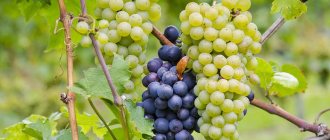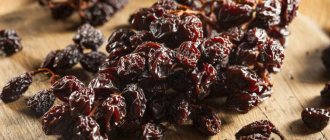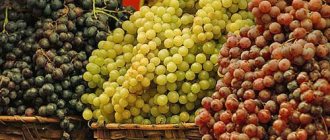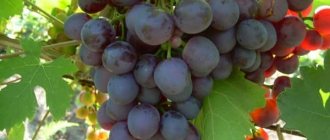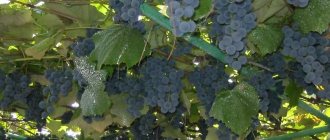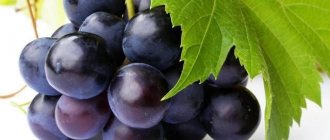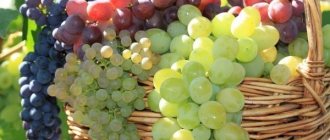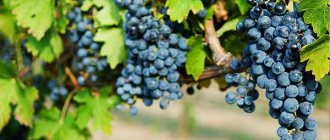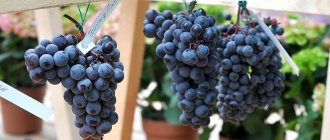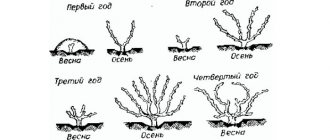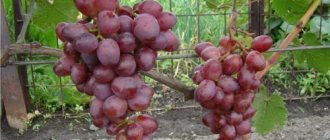Description of grape varieties
Each of the presented types is distinguished by good taste, good harvest, and undemanding conditions of growth and care. All of them can be grown by both professional winegrowers and beginners.
The TOP 10 best varieties of berries include:
- Arcadia is a table type that carries the Cardinal and Moldova genes. It belongs to the early varieties and ripens in 115 to 125 days. Bushes are medium or vigorous. The cultivation of berries is widespread in central Russia due to frost resistance, including in the Urals.
- Kishmish is oval white - it is distinguished by small, neat berries of pale green color. Their characteristic feature is the absence of developed seeds and the presence of a thin skin, which is practically not felt when eating the fruit fresh.
- Pinot noir is a technical type of grape cultivated for the production of elite wines. It is grown in France, Italy, Spain, and America. In terms of morphological differences and biological characteristics, it is close to the ecological and geographical group from Western Europe.
- Baikonur - has a specific appearance: the berries are elongated, with a pointed end. Its key advantages: normal reaction to low temperatures and heat resistance; also, in the absence of high moisture levels, the fruits do not wrinkle and retain their sweet taste.
- Riesling - this type looks similar to white sultanas, but its green color is paler, and the berries are much larger. Their shape is the same round. Most often, they are used to produce environmentally friendly, dietary juices, dry, sparkling and strong wines. It grows in Bulgaria, France, Italy and a number of other countries.
- Cabernet Sauvignon is one of the most popular types among winemakers, belonging to the technical group. It comes from France and is cultivated in Bulgaria, Romania, the USA and many other countries of the world. Cabernet Sauvignon perfectly resists various pests: gray rot, bunch budworm, etc.
- In Memory of Negrul - interesting because of its marketable appearance and excellent keeping quality, which allows it to be successfully grown for mass sales. However, it is better not to consume this grape variety in large quantities for patients with diabetes due to the high concentration of sugars in the fruits - 14.3%.
- Isabella is the most scandalous type in the ranking, which has long been prohibited for cultivation for commercial purposes in the EU. The reason for the notoriety was the allegedly high concentration of methanol in the composition. However, it remains popular in private vineyards due to its low maintenance and lack of need for treatment with pesticides.
- Transfiguration is a hybrid obtained by combining the genes of Kishmish radiata and Talisman. It is valuable due to its early ripening period lasting 110-125 days. The berries are distinguished by their richness of taste and excellent presentation.
- Original - this name fully corresponds to the type of fruit: pink color, large size, elongated shape with a flattened end, beautiful bunch. It is grown both for themselves and for sale. The fruits are quite fleshy and juicy.
The best cultivators
How we chose
To prepare the TOP, we studied many reviews from experienced winegrowers and numerous characteristics of the varieties - from keeping quality to the taste of the berries.
Here's what came into focus:
- Variety - white, black, pink, wine, red;
- Ripening dates – early, middle, late;
- Weight and size of bunches;
- Diameter and shape of berries;
- Taste and juiciness of fruits;
- Peel density;
- Level of sugar content;
- Acidity;
- Need for care;
- Frost resistance;
- Resistance to various pests;
- Type – non-covering or requires protection with film;
- Productivity;
- Reproduction method;
- Rootstock compatibility;
- Rooting of cuttings.
- Requirements for climatic growing conditions;
Also, when selecting good varieties, we paid attention to their type - table or technical. The scope of their application was also taken into account - raw consumption, production of raisins, production of juices, wines, champagne.
The best dryers for vegetables and fruits
The best white grape varieties
This type is consumed raw and used to make juice, raisins, and white wine. The berries are pale green, almost white, oval or round in shape. It is often cultivated for sale. We present the 2 best grape varieties, according to reviews from winegrowers, which were selected for their juicy pulp, delicate taste and excellent keeping quality.
Arcadia
This table variety, originally from Ukraine, was obtained by crossing the well-known species “Moldova” and “Cardinal”. It belongs to the early types and ripens within 115-125 days, in August. The plant has large clusters weighing from 500 g to 2 kg. Arcadia's berries are oval-shaped, white, fleshy and juicy, weighing from 9 to 16 g. The skin is dense, but not hard and sweetish. The fruits have a slight nutmeg flavor.
"Arcadia" easily adapts to various growing conditions, so it can be planted not only in the south of Russia. The seedlings are unpretentious to care and can withstand frosts down to -22 degrees Celsius. The cuttings take root well and produce a powerful root system. There are two types of pruning of bushes - short and long. Ripe fruits last a long time and have good transportability, so they are especially relevant for sale.
Advantages
- Average disease resistance;
- Delicious juice;
- High yield;
- Low acidity – 4-6 g/l;
- The shoots ripen well.
Flaws
- Sensitive to excess fertilizers;
- If the soil is elevated or excessively dry, the fruit may crack.
Reviews say that on average the number of fruitful shoots is 55-75%, and the fertility coefficient is at the level of 1.1-1.5.
Kishmish oval white
The “Kishmish oval white” grape has many synonyms - Sultanina, Autobi, Murray River Pinot, etc. It comes from the countries of the Middle East and Central Asia, and is the result of a bud mutation of representatives of the eastern ecological-geographical group. The bushes are large and the shoots ripen well, but to increase the size of the berries, it is still recommended to use gibberellin after the ovary appears.
Oval white sultana has no or underdeveloped seeds, which is why it is often chosen. The thin, transparent skin, which is easy to chew, also gave this species a good reputation. The berries are quite sweet due to their sugar content of 22-30% and acidity of 6 g/l. On average, 160 days pass from the moment the buds open until they mature. It is valuable due to its good yield of 100-200 c/ha, but for this, agricultural technology must be at a high level.
Kishmish's clusters are medium in size and weigh about 230 g. The fruits are small, oval in shape, with fleshy pulp. They are consumed both fresh and used for preparing white raisins, preparing bedon, soyagi, and golden sabza. Sultanina has proven itself well, in particular, due to its excellent keeping quality and trouble-free transportability. Therefore, in the description of the variety it should be mentioned that it is best suited for sale.
Advantages
- Frost-resistant – can withstand temperatures down to -22°C;
- Undemanding to soil;
- Easy to trim;
- Good compatibility with rootstocks;
- Excellent rooting of cuttings;
Flaws
- Not very high resistance to pests and fungal diseases.
Due to its high yield and marketable appearance, these grapes are often grown for sale.
Krasnodar region
The climatic conditions of the Krasnodar Territory are considered ideal for grapes, so the best varieties are grown in this area. The ratio of warm days a year, average precipitation and sunlight make a good foundation for stable fruiting of the vineyards.
The main grape production is concentrated in the Anapo-Taman zone. The harvested crop is distributed to other industries for processing and to markets for fresh consumption. Harvesting time begins in the third decade of July and lasts until mid-October.
It is impossible to list all the varieties grown in the Krasnodar Territory, since the vineyards are constantly replenished with new developments by breeders. The following varieties of culture are considered the most popular:
Madeleine Angevin
Vigorous plant of early ripening. The harvest begins in mid-August. Productivity depends on the quality of pollination; the best pollinator is Chasselas, so both crops are planted nearby. The average weight of a bunch reaches 180-200 g. The berries contain 15% sugar and 6.7% acid.
Pearl Saba
The berries ripen in late July - early August. The yield is high (over 8 kg per bush), the stepsons bear fruit abundantly. After planting the chibouks, the plant bears fruit for 2-3 years. The ratio of sugar content (16%) and acidity (7.3%) is close to ideal. It has strong immunity and resists fungal diseases. Due to the shortage of planting material, propagation by grafting is practiced.
Chasselas white
It is one of the main ones, which is grown massively in the Krasnodar region. The plant enters the fruiting phase early (already in the 2nd year), the bush is formed of medium size, the immunity is strong, which can be seen in resistance to fungal diseases. The berry has high taste (sugar 15%, acid 6.7%) and good transportability.
An early ripening variety, found throughout the region, but in small quantities. The harvest is ready for harvest in the third ten days of August. On tall bushes, large clusters are formed abundantly, the weight of which reaches 420-500 grams. Productivity depends on the quality of pollination; the best pollinator is Chasselas, so both crops are planted in close proximity. Sugar content – 14%, acidity – 6%.
Muscat Hungarian
The plant enters the fruiting phase in the 3rd year after planting the seedlings. Muscat bushes are medium-sized with actively developing vines. The honey taste of the berries indicates a high sugar content (more than 20%), with relatively low acidity (6.5%). A medium-sized bunch weighs up to 160-170 grams. Intended for fresh consumption of berries and for processing into juices.
Cinsault
The plant comes from France and is characterized by high productivity. More than 7 kg of berries are removed from the bush. The grapes reach ripeness by the second half of September. The berries are large in size, dark blue in color with a characteristic waxy coating. The taste harmoniously combines sugar content (18.3%) and acidity (7%). The weight of a medium-sized bunch is 232 grams.
An equally varied menu of grape varieties grown on the peninsula. The total number of varieties is close to a hundred. Favorable climatic conditions and soil fertility contribute to high yields. The lack of precipitation is compensated by equipping the vineyards with a drip irrigation system. When planting plants, the following scheme is used: 3x1.5 m. The largest plantations are located in the foothill zone (Bakhchisaray district), steppe zone (near Simferopol), as well as in the suburbs of Yalta, Alushta, Sudak.
Among the fruitful ones the following stand out:
Agadai
The table variety comes from Dagestan and is distinguished by its late ripening period. Harvesting begins no earlier than the 20th of September. The plant develops normally in soils with a high salt content. In addition to fresh consumption, the crop is used for canning and making juices.
Albillo Crimean
A medium ripening plant native to Spain. Grown for winemaking. The yield is 7-9 kg per bush. The berry contains 14% sugar and 6.7% acid.
Italy
Large grapes collected in loose clusters, the average weight of which reaches 450 grams. Yellow-amber berries have a pleasant taste with a pronounced nutmeg note.
Cardinal
The berries ripen by the end of August. The bunch is formed loose with a large number of grapes, the average weight is 250-350 grams. The taste is not cloying, although it contains at least 16-17% sugar. It is resistant to fungal diseases and has good transportability.
Read also: Effects of bee venom on humans
Citron Magaracha
Wine variety with early ripening. The quality of taste and presentation makes the berry edible and fresh. The weight of a cylindrical brush reaches 400 g. Sugar content is high (23%) with acidity 5-7%.
Sabbat
The crop is grown for fresh consumption and for the production of wine material. White berries ripen in late September - early October. Large bunches weigh up to 280 g. Even after being stored in the refrigerator for 5 months, the grapes do not lose their taste and commercial qualities.
The best red grape varieties
Raisins and red wine are most often made from such grapes. It can be sweet or sour, depending on the amount of sugars in the berries. Most often, there are several seeds inside the fruit. This rating included the most delicious, picky and beautiful varieties.
Pinot noir
The red technical variety Pinot Noir is primarily grown for the production of wines and juices. It was bred in Burgundy and is widespread in all wine countries of the world: Italy, Australia, New Zealand. This species is also known as Blauburgunder, Noirien and Spätburgunder. The grapes are not easy to cultivate, so they are most often planted by professional winemakers.
Pinot noir has clusters of small or medium size (length - about 10 cm, width - about 7 cm), cylindrical-conical in shape. The diameter of the berry is approximately 15 mm. Their skin is very dense, the pulp is tender and juicy, and the juice is almost colorless. The fruits are almost black, with a pronounced sweet taste and contain only 2-3 not very hard seeds.
Pinot noir has a long growing season - on average, the berries ripen in 141-151 days. The harvest can be harvested around the end of September. The bushes grow well and the vine ripens quite quickly - by the time the fruits ripen, this process is 85-90% complete. A fruitful shoot produces about 1.4-1.9 bunches, and a developed shoot produces about 0.9.
Advantages
- The average sugar content of the juice is 21.4 g/100 ml;
- Early maturation;
- Good yield;
- Calmly tolerates low temperatures;
- Pronounced taste.
Flaws
- More sour than similar varieties in the rating;
- Sensitive to planting conditions;
- Not a very good reaction to flat terrain.
Pinot noir is only rarely combined with other varieties to make wine, but it is sometimes combined with Chardonnay and Pinot gris in Champagne.
Baikonur
The hybrid variety “Baikonur” was obtained by crossing Krasotka and Talisman. It ripens one of the first in the ranking - in early August. The bushes are actively growing. The clusters have an average density and are quite large - weighing 500-1000 g. The berries are almost purple, elongated, large, weighing about 11 g. They are mainly eaten raw or used to make raisins.
Baikonur fruits have a thick skin, so they are often consumed without it. Their taste is strong and harmonious, the flesh is quite sweet and juicy. This grape variety behaves better at low temperatures, for example, in the Moscow region. The bushes produce good yields both in warm climates and in central Russia due to their resistance to frost.
Advantages
- Excellent transportability;
- High resistance to fungal diseases;
- Beautiful, marketable appearance;
- The fruits do not spoil for a long time when stored in the refrigerator;
- Smells nice.
Flaws
- Requires careful care;
- They have a weakness for fertilizers.
Experienced summer residents note in reviews that the bushes of this grape have average immunity to gray rot, oidium, and mildew.
Astrakhan region
A promising area for growing grapes is the Astrakhan region. This is facilitated by the hot climate and the presence of Baer mounds. Deep groundwater gives plants a better chance of surviving winter frosts.
Over the entire period of the existence of viticulture on an industrial scale, more than 300 varieties have been tested on the Baer hillocks. The highest results were noted when cultivating the following varieties.
Codrianka (white)
The plant has a medium-late ripening period with a growing season of 130-140 days. The berries are greenish-yellow in color and have a round-oval shape; the weight of one reaches 10-12 grams. The weight of a medium-sized brush is 600-800 g, but there are also giants weighing 1.2 kg. The shrub easily tolerates frost down to -23°. Codriana is resistant to mildew and gray rot.
Delight
Early, with a growing season of 110-120 days. It is characterized by increased resistance to fungal diseases and mildew. Frost resistance (down to -25°) allows you to endure harsh winters under cover. The yield of Delight grapes is more than 9 kg per bush.
Kishmish radiata
Pink grapes of medium early ripening (vegetation period 115-125 days). Advantages: high taste, commercial value, long shelf life. The weight of a medium-sized bunch reaches 250-450 g. Sugar content is 17-21%, acidity is 6-7%.
Moscow
The early ripening plant is distinguished by its unusual taste, filled with nutmeg and pineapple aromas. The culture is resistant to low temperatures and fungal diseases. The bunch is small, weight does not exceed 150 grams.
The best grape varieties for wine
Alcoholic drinks are made mainly from technical grape varieties. Canteens can also be used for this, but mainly at home, to produce small batches of wine or champagne. Often several types of culture are combined within one composition. Next we will talk about the two most popular types of berries among winemakers, which are cultivated all over the world.
Riesling
White grapes from the Riesling technical group have many names - Lipka, Netherlander, Gewürztraube and a number of others. It was first discovered on the banks of the Rhine River in Germany, and today it is widely cultivated in Romania, Bulgaria, Hungary and other countries. Since its yield is not the highest (87% of fruitful shoots), growing it for the production of large quantities of wine is not very profitable.
Riesling ripens, like most grapes, at the beginning of the third ten days of September. On average, it takes him from 148 to 160 days; the warmer it is, the better the process. The bunch of bushes is small or medium in size: width - about 7 cm, length - about 9 cm, weight - around 100 g. The diameter of the berry is 11-15 mm, it has a round shape and a thin, durable skin. Inside there is juicy pulp and 2-4 small seeds.
Advantages
- Late opening of eyes;
- Mold improves the composition;
- Fruit ripening continues until the last months of autumn;
- Varietal individuality;
- Tolerates winter well;
- Suitable for more than just wine.
Flaws
- Not very resistant to rot and oidium;
- Susceptible to bacterial cancer;
- Peculiar taste;
- Flowers may fall off.
Berry affected by noble rot loses a lot of moisture, as a result of which the content of sugars and aromatic substances increases.
Cabernet Sauvignon
This is one of the most popular and best grape varieties for the production of red wines. It is the result of crossing Sauvignon Blanc and Cabernet Franc. Until 1990, this species was the leader in terms of cultivation volumes in the world, until Merlot overtook it. The bushes are unpretentious to care and grow in completely different climatic conditions, so beginners in winemaking often take up their cultivation.
Cabernet Sauvignon is relatively frost-resistant, but is intended primarily for growing in warm-temperate climates due to its late ripening. It produces a very tart wine with a rich taste due to the high concentration of tannins in the composition. It is characterized by the original taste and aroma of black currant. It has a high alcohol content, which is why this variety is often mixed with other, softer ones.
Advantages
- Noble taste;
- Pleasant aroma;
- After drinking wine based on it, there is no headache;
- Neat fruits;
- The berries practically do not fall off.
Flaws
- Not very suitable for growing in Siberia.
Winegrowers believe that for effective cultivation of this grape it is better to choose flat clay areas with excellent drainage or those exposed on hills.
The best black grape varieties
Black grapes are called because of their dark purple berries. The riper it is, the stronger this shade. This variety is very popular for growing for wine production on a large scale, as well as for making raisins. This TOP category describes the most productive and delicious varieties.
In memory of Negrul
The variety “In Memory of Negrul” differs significantly from its analogues in its oval shape and very dark, almost black color. It is characterized by large, strong, heavy bunches weighing about 320 g and measuring about 20x12 cm. They are quite beautiful and retain their presentation for a long time. This grape contains a lot of sugars - 14.3%, so patients with diabetes should use it with caution.
The yield of the variety is decent - 105 centners per hectare, and it can be further improved by developing agricultural techniques. Ripe berries are soft and juicy, but their taste is not original. Their size is approximately 3x1.9 cm, and their weight is 5-7 g. Memory Negrul is a table variety, intended primarily for consumption raw.
Advantages
- Increased resistance to gray rot and other parasites;
- Excellent winter resistance;
- High density;
- The fruits almost never crack;
- No sour taste.
Flaws
- When pruning, it needs a more active load with its eyes.
In general, Memory Negrul has good taste and is not particularly demanding in care, so it is suitable for cultivation by amateurs in their dachas.
Isabel
We present an American hybrid variety, bred by crossing two species - Vitis vinifera and Vitis labrusca. It is also known around the world as Fragola and Albani Surprise. This crop is cultivated in Bali, Brazil, Japan, and Russia. It is thermophilic and thrives in high temperatures. This grape perfectly resists various pests, including demonic phylloxera. Thanks to this, the bushes do not need to be treated with pesticides.
Isabella has good productivity, and does not particularly need fertilizing. Even though they are table grapes, they make quite tasty wine and juice. However, on a commercial scale, the production of such drinks is unprofitable and is even prohibited in the EU. Most often, wine is made from it at home, for oneself.
Advantages
- Uncovered;
- The skin comes off easily from the pulp;
- Juicy;
- Soft.
Flaws
- Late maturation.
In Russia, "Isabella" is cultivated in Dagestan and the Krasnodar region. However, it can grow freely in Siberia, the Moscow region, the Black Earth Region, the Volgograd and Rostov regions.
The best pink grape varieties
This is the most interesting berry, the color of which is at the junction of white and black. They can be eaten fresh, used for drying raisins or making juice. Sometimes they make wine. For these purposes, the 2 varieties described below are best suited.
Transfiguration
The new variety “Preobrazhenie” is another hybrid in the ranking, created by breeder V.N. Krainov. It was obtained by crossing two independent species “Kishmish radiata” and “Talisman”. The plant boasts early ripening, around 110-125 days. It belongs to the group of table grapes intended for consumption mainly fresh.
The bunch of “Preobrazheniya” is cylindrical or conical, weighing from 0.7 to 1.5 kg. The berries are convex, oval, elongated, pink, weighing about 15 g and measuring about 36x24 mm. Their characteristic features are juiciness, a light waxy coating and slight sourness, while the acidity level of the fruit is relatively low - 6-8 g/l. The pulp contains a large volume of juice and a lot of sugar - up to 19%, so this grape variety is best suited for making juice and compote.
Advantages
- Average resistance to fungal infections;
- Ease of adaptation to weather changes;
- Good frost resistance – down to -23C°;
- Not picky about soil quality;
- Easy to care for.
Flaws
- Not very reliably protected from parasites.
To successfully grow "Transfiguration" requires good lighting and the absence of trees nearby.
Original
The grape variety in question is a table grape variety and belongs to the mid-late ripening category. The fruits ripen at about 135-145 days. The bushes grow well and form large vines. The bunches weigh about 600 g and have a conical shape. The berries are mainly consumed fresh, sometimes used to make preserves, jams, and compotes. They are distinguished by their large size (30x22 mm), elongated ovoid shape, and strong skin.
The “Original” variety is quite fruitful - 65-80% with a coefficient of 1.2-1.7. But for this, the vines need to be cut to 8-12 buds. Its yield is average, although the grapes resist rot, oidium, and mildew well, and are well preserved in frost. He loves care and requires a high level of agricultural technology.
Advantages
- Strong growth of bushes;
- Good ripening of shoots;
- Productivity – 120 centners per 1 ha;
- The brushes have a presentation;
- The berries are juicy.
Flaws
- There are a lot of unripe stepchild crops.
According to reviews, its pulp is slightly liquid and the peel is practically not felt when biting the berry.
Tyfi is white.
The variety is widespread in the Uzbek and Tajik SSR. For production testing, it will be planted in the irrigated vineyards of the Don. Taifi white is a good table variety. Its berries are strong and beautiful. When stored in winter, they retain their shape for a long time (almost never fade). The leaves are dark green, dense, deeply cut, five-lobed (the lower leaves are almost entire), net-wrinkled above, glabrous below. The petiole notch is closed or open. Marginal teeth with convex sides, sharp. The flowers are bisexual. The clusters reach a very large size (up to 30 centimeters in length), conical, with highly developed lateral branches, medium density or loose. The berries are large, oblong, sometimes almost cylindrical with a blunt tip, greenish-white or with a faint pink tint. The skin is thick, durable, the flesh is dense and crispy. The famous Central Asian variety Taifi pink is very close to Taifi white in all its characteristics, with the exception of the pink color of the berries. Tyfi is white.
- Back
- Forward
Which grape variety is better?
For planting for the purpose of eating fresh berries, making compote and juice for yourself, table grapes are usually planted. Those who are professionally involved in winemaking are advised to pay attention to representatives of the technical group, who were specially selected to produce wine, champagne, and raisins on a commercial scale.
Here's what grape variety is good in different conditions:
- Arcadia, Baikonur, and Riesling are excellent for growing in central Russia.
- In the south of the Russian Federation (Krasnodar Territory and Dagestan) you can cultivate Kishmish oval white, Cabernet Sauvignon, Memory Negrul, Preobrazhenie.
- In the Moscow region, Original, Isabella and Pinot noir have proven themselves to be excellent.
In order not to get confused in such a wide variety of grape varieties, carefully study their descriptions and characteristics, read the reviews of winegrowers and winemakers, decide on the purposes of cultivation, and only then make your choice.
Growing grapes in different regions of Russia
The territory of Russia is vast, so the climate in the regions can differ significantly. In many parts of the country, crops such as grapes are successfully grown. In addition, the grapevine is unpretentious to the soil, the only exceptions being saline and wetlands. Before planting the seedling, the soil is fertilized with organic matter. It is enough to enrich the soil once a year. When choosing a location, it is worth considering that the plant’s life cycle is approximately 25-30 years, so you need to indent 1.5 m from the walls of the fence and buildings. The best time for planting is considered to be autumn, namely the month of September. But the timing may vary depending on the climatic characteristics of the regions.
Many gardeners are engaged in viticulture, both in the south of Russia and in regions with harsh climatic conditions
In order to consistently get a good harvest from the vine, you need to choose varieties recommended for growing in certain conditions.
